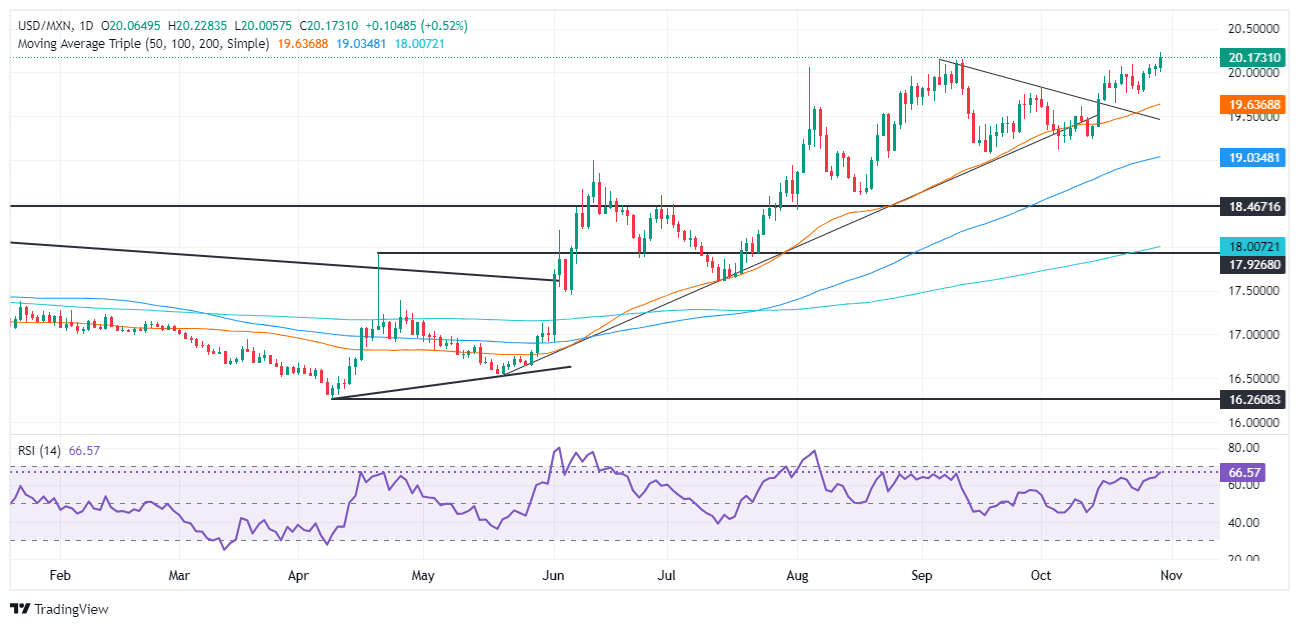- The Mexican Peso weakens due to strong US data and political uncertainty linked to Mexico’s judicial reform.
- Mexico’s Q3 GDP beats forecasts, but US ADP employment data and resilient GDP growth boost USD.
- Traders are keeping an eye on upcoming data, including Mexico business confidence and the PCE price index and US nonfarm payrolls.
The Mexican Peso extended its losses against the US Dollar for the fourth consecutive day on Wednesday, falling 0.62% even as Mexico’s economy grew above estimates. In the US, a stellar ADP employment report and robust GDP growth in the third quarter boosted the Dollar. Therefore, USD/MXN is trading at 20.18 after bouncing from a daily low of 20.00.
The National Institute of Statistics, Geography and Informatics (INEGI) revealed that Mexico’s Gross Domestic Product (GDP) figures for the third quarter of 2024 surprisingly exceeded estimates. Meanwhile, political turmoil linked to Mexico’s judicial reform continued, as eight of the Supreme Court’s eleven judges announced their resignation effective August 2025.
Across the border, data hinted that the US Federal Reserve’s (Fed) soft landing scenario continued to gain traction. The US ADP employment change for October surpassed the mark, dismissing fears that the labor market is weakening. Meanwhile, US GDP data for the third quarter of 2024 fell below estimates and the second quarter reading.
Looking ahead to the week, Mexico’s economic calendar will include the release of business confidence and the S&P Global manufacturing PMI. Across the border, the US agenda will include the Fed’s favorite inflation gauge, the core personal consumption expenditure (PCE) price index and non-farm payrolls (NFP).
Daily Market Summary: Mexican Peso Plunges Following Strong GDP Data in Mexico and US
- Mexico’s GDP for the third quarter of 2024 grew 1% quarter-on-quarter, exceeding the consensus of 0.8% and the 0.2% growth of the second quarter. On an annual basis, GDP grew by 1.5%, above forecasts of 1.2%, but fell below the 2.1% achieved in the previous quarter, indicating the ongoing economic slowdown.
- Therefore, the ongoing economic slowdown and disinflation could open the door for the Bank of Mexico (Banxico) to reduce borrowing costs at the November meeting.
- Money market futures suggest that Banxico is expected to cut between 175 and 200 basis points over the next 12 months.
- The national ADP employment change in October increased by 233,000, above estimates of 115,000 and 159,000 in September.
- The US Bureau of Economic Analysis revealed that the US economy grew 2.8% year-on-year in the third quarter of 2024, below the final second quarter reading and estimates of 3%.
- Other data showed that pending home sales in September rose 7.4% month-on-month, above estimates and figures from August. In annual terms, sales grew by 2.6%, compared to the -3% contraction in August.
- Data from the Chicago Board of Trade, via the December federal funds rate futures contract, shows that investors are estimating a 49 bp cut by the Fed by the end of the year.
USD/MXN Technical Outlook: Mexican Peso Plunges as USD/MXN Breaks Above 20.15
USD/MXN extended its uptrend and tested the yearly high of 20.22, as buyers seem reluctant to push the exchange rate beyond that area. If they break that level, the next would be the psychological level of 20.50, the September 28, 2022 high at 20.57 and the August 2, 2022 peak at 20.82. Once surpassed, the next stop would be the March 8, 2022 high at 21.46.
On the other hand, if sellers take USD/MXN below 20.00, the first support would be the October 24 daily low of 19.74, followed by the 50-day SMA at 19. 62.
The oscillators indicate that the buyers are gaining strength, as shown by the Relative Strength Index (RSI) above its neutral line, surpassing the previous highs reached on September 10 and August 22.
The Mexican Peso FAQs
The Mexican Peso (MXN) is the most traded currency among its Latin American peers. Its value is largely determined by the performance of the Mexican economy, the policy of the country’s central bank, the amount of foreign investment in the country and even the levels of remittances sent by Mexicans living abroad, particularly in the United States. . Geopolitical trends can also affect the MXN: for example, the nearshoring process (or the decision by some companies to relocate manufacturing capacity and supply chains closer to their home countries) is also seen as a catalyst for the currency. Mexican, as the country is considered a key manufacturing center on the American continent. Another catalyst for the MXN is oil prices, as Mexico is a key exporter of the raw material.
The main objective of Mexico’s central bank, also known as Banxico, is to keep inflation at low and stable levels (at or near its target of 3%, the midpoint of a tolerance band between 2% and 4%. %). To do this, the bank establishes an appropriate level of interest rates. When inflation is too high, Banxico will try to control it by raising interest rates, which makes borrowing more expensive for households and businesses, thus cooling demand and the economy in general. Higher interest rates are generally positive for the Mexican Peso (MXN) as they lead to higher yields, making the country a more attractive place for investors. On the contrary, lower interest rates tend to weaken the MXN.
The publication of macroeconomic data is key to evaluating the state of the economy and can have an impact on the valuation of the Mexican peso (MXN). A strong Mexican economy, based on high economic growth, low unemployment and high confidence is good for the MXN. Not only does it attract more foreign investment, but it may encourage the Bank of Mexico (Banxico) to raise interest rates, particularly if this strength is accompanied by high inflation. However, if economic data is weak, the MXN is likely to depreciate.
As an emerging market currency, the Mexican Peso (MXN) tends to rise during periods of risk, or when investors perceive overall market risks to be low and are therefore eager to engage in investments that carry higher risk. . Conversely, the MXN tends to weaken in times of market turbulence or economic uncertainty, as investors tend to sell riskier assets and flee to more stable safe havens.
Source: Fx Street
I am Joshua Winder, a senior-level journalist and editor at World Stock Market. I specialize in covering news related to the stock market and economic trends. With more than 8 years of experience in this field, I have become an expert in financial reporting.








